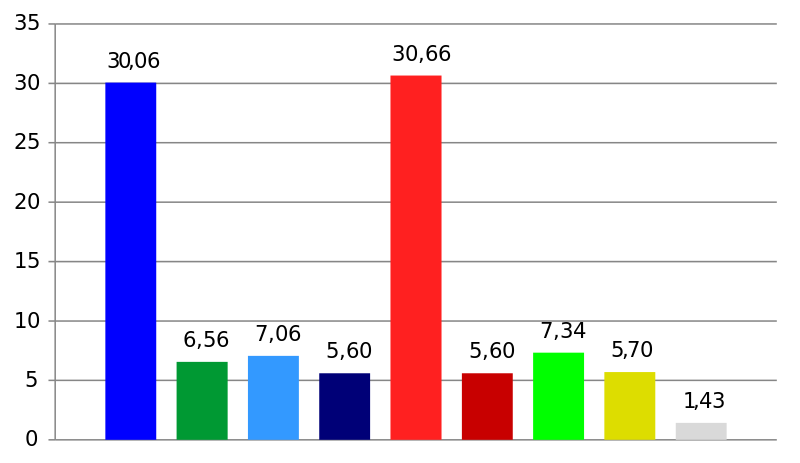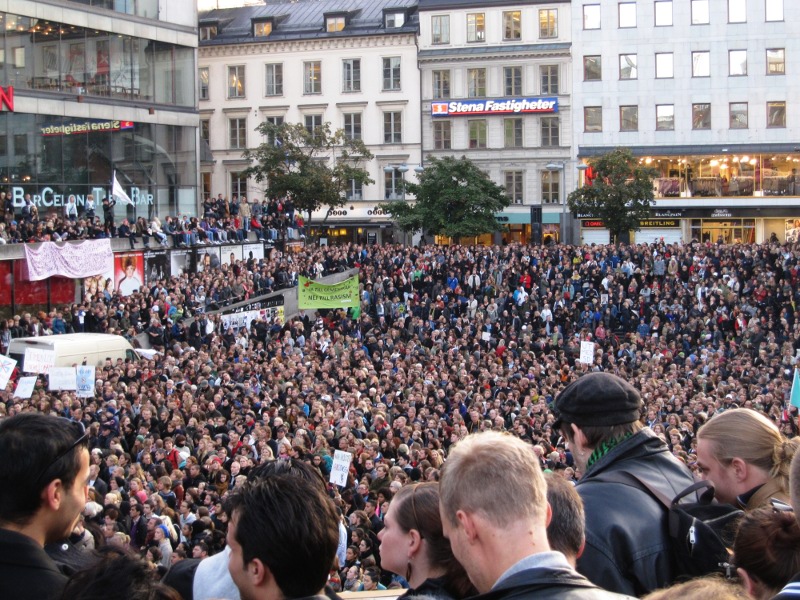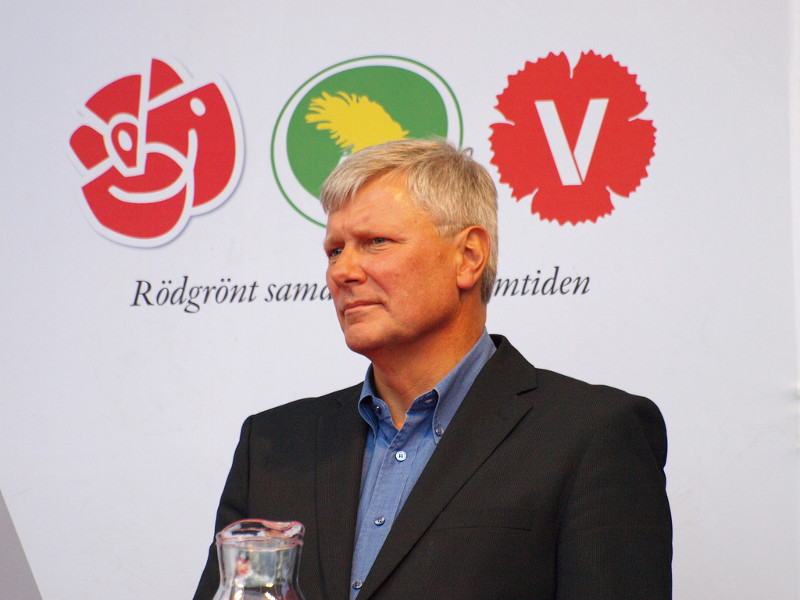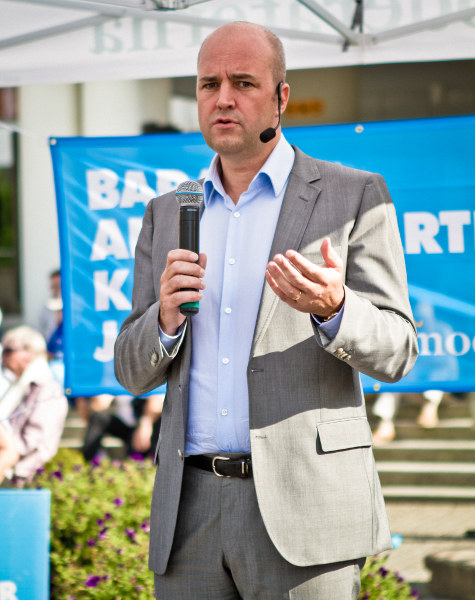The recent elections in Sweden were hailed as a victory for the right wing and particularly the racist “Sweden Democrats”. However, in reality the election reflects long-term dissatisfaction with the rolling back of the Swedish welfare state, to which the Left-Green coalition has no answer. The Left Party, in particular, needs to change course in order to set itself up as a clear alternative for the workers and youth.
A victory for the right wing?
The bourgeois government hung on to office in the Swedish general elections after receiving about 49% of the votes compared to 43 % for the Red/Green alliance of the Social Democrats, the Left Party and the Greens. The result was a disaster for the Social Democrats who lost 5%, compared to the last election in 2006, and went down to 31%, their lowest vote since 1912, but it also meant that the right-wing government lost it's majority in Parliament as a result of that the “Sweden Democrats”, a right-wing racist party, won 5.6 %.
One of the reasons for this result can be found in the fact that the Swedish economy has recovered somewhat since the crisis last year. Export industries produce mainly iron, ore, steel, paper and investment goods and is benefitting from the temporary boost in demand on the world market. The home market is strong because of tax cuts and a 0.5 % interest rate. This, combined with the relatively small bank bail-outs, means that the state finances are showing a surplus. This benefitted the outgoing government for the time being.
Another reason is that the main party of the bourgeoisie, the “Moderates”, removed their most right wing policies from their programme and showed a more “human face” in order to win more votes. They have tried to drop their old image and act as a kind of “new” Social Democratic Party which is defending the “Swedish model”. They even go as far as calling themselves “the only workers’ party”. In reality, of course, they have launched an attack on quite a number of key general welfare benefits, such as sick pay and unemployment benefit as well as privatising and deregulating a range of industries.
A programme without solutions
 Mona Sahlin. Photo: Lena Dahlström Most important, however, is the fact that the Social Democrats and the Left Party have moved to the right. Their election manifestos differed from that of the government only in quantity. Anecdotally, voters voting for the Moderates claimed that they would have voted for the Social Democrats if they were the Social Democrats of the 1940s. The electorate remained more or less equally divided between considering themselves right-wing (42%) and left-wing (38%). On the surface, the programme that the Red/Green opposition presented contained some positive proposals regarding investment in infrastructure, housing and more jobs in the public sector. However, without more radical demands, the programme lacked credibility.
Mona Sahlin. Photo: Lena Dahlström Most important, however, is the fact that the Social Democrats and the Left Party have moved to the right. Their election manifestos differed from that of the government only in quantity. Anecdotally, voters voting for the Moderates claimed that they would have voted for the Social Democrats if they were the Social Democrats of the 1940s. The electorate remained more or less equally divided between considering themselves right-wing (42%) and left-wing (38%). On the surface, the programme that the Red/Green opposition presented contained some positive proposals regarding investment in infrastructure, housing and more jobs in the public sector. However, without more radical demands, the programme lacked credibility.
Swedish workers have for the past 30 years seen a rolling back of the welfare state. Deregulation, privatisation and cuts in public services and benefits have produced a society with social problems not seen since the 1930s: crime, overcrowded housing, homelessness and poor health. The bourgeoisie has been on the offensive and the labour movement has not been able to stop it. And for most of these 30 years the Social Democrats have been in government.
The Left-Green coalition did not present a radical programme with which the labour movement could take up the struggle against this offensive of the bosses (often referred to as “neo-liberalism”). In fact, the leader of the Social Democrats, Mona Sahlin, showed mainly resignation when asked whether she would reverse the attacks on the sick and the poor. She replied saying that “we can’t answer that question, because we don’t know what the situation will be when we take over”. Their programme against unemployment similarly argued for cuts to employers’ contributions (effectively a wage cut, as trade unionists would know). This defeatism did little to rally the trade unions and the rank and file against the cuts. The anger displayed by ordinary workers against the right-wing government could only go so far. In the past year what seemed like an easy victory for the Left-Greens turned into a defeat in spite of the fact that three out of four blue collar workers supported the two workers’ parties and the Greens.
 Moderates (dark blue), Center (dark green), People's Party (liberal, light blue), Christian Democrats (purple), Social Democrats (light red), Left Party (dark red), Green Party (light green), Sweden Democrats (yellow). Illustration by Caelus sv. At the last minute, it seemed that the leadership of the Social Democratic Party had realised this and Mona Sahlin made a few left speeches, including arguing for a society that worked according to the principle “from each according to ability, to each according to need”. Yet, this must have seemed like an empty phrase in the context. The polls improved in the last days prior to the election when the press started writing about the effects of the government's attack on sickness benefit but it was not enough to change the outcome. It might, however, have robbed the right-wing coalition of their majority in Parliament.
Moderates (dark blue), Center (dark green), People's Party (liberal, light blue), Christian Democrats (purple), Social Democrats (light red), Left Party (dark red), Green Party (light green), Sweden Democrats (yellow). Illustration by Caelus sv. At the last minute, it seemed that the leadership of the Social Democratic Party had realised this and Mona Sahlin made a few left speeches, including arguing for a society that worked according to the principle “from each according to ability, to each according to need”. Yet, this must have seemed like an empty phrase in the context. The polls improved in the last days prior to the election when the press started writing about the effects of the government's attack on sickness benefit but it was not enough to change the outcome. It might, however, have robbed the right-wing coalition of their majority in Parliament.
Many voters felt that there was little difference between the two blocks and that they were only competing in promising improvements to different groups, for instance tax cuts for the retired and subsidies to the local councils. Because of this the government was able to win, mainly on the basis of winning votes from male white collar workers and older people. Many of them simply saw very little difference between the two sides. The Left-Green coalition failed to present even a serious reform programme, not to talk about any anti-capitalist messages which were completely absent.
The rise of the far-right
The growth of the Sweden Democrats, who got 20 seats in parliament and seats in most local authorities, is a clear indictment of the policies of the Red-Green coalition. The racist demagogy of the Sweden Democrats struck a chord among certain backward layers of the unemployed and the youth who are looking for some explanation for the increasingly difficult situation they find themselves in. This party talks about all the concerns of working class people: unemployment, crime, the environment, schools, healthcare and pensions. However, its programme, in short, is to introduce a “responsible immigration policy”, which puts “Swedish people” first.
When all the other parties seem largely content with the status quo, some can be tempted by this alternative. The solution, however, must lie in working out a socialist programme that addresses the concerns of working class people.
 Demonstration against Sweden Democrats. Photo: Daniel Mott. The winning of seats by this party provoked more or less spontaneous mass demonstrations. The leader of the Left Party called on election night for a mass campaign against racism. Already on the day after the election 10,000 protested in Stockholm, 5,000 in Gothenburg and 2,000 in Malmoe. This shows the aversion that working class people have towards racism and they will put pressure on the left leaders not to follow the Danish example, where the Social Democratic Party adapted itself to this kind of right-wing opportunism. Yet, there were serious mistakes by the organisers, something that was also echoed by Lars Ohly, the leader of the Left Party.
Demonstration against Sweden Democrats. Photo: Daniel Mott. The winning of seats by this party provoked more or less spontaneous mass demonstrations. The leader of the Left Party called on election night for a mass campaign against racism. Already on the day after the election 10,000 protested in Stockholm, 5,000 in Gothenburg and 2,000 in Malmoe. This shows the aversion that working class people have towards racism and they will put pressure on the left leaders not to follow the Danish example, where the Social Democratic Party adapted itself to this kind of right-wing opportunism. Yet, there were serious mistakes by the organisers, something that was also echoed by Lars Ohly, the leader of the Left Party.
Some of the organisers called for everyone to join in, regardless of who they had voted for, and for the demonstrations to be “apolitical”. Similarly, Lars Ohly proclaimed his “conviction that Fredrik Reinfeldt is an incredibly convinced anti-racist” in spite of the fact that he stands for a “lousy policy on a class, region and environmental basis” (Ohly: Reinfeldt är en övertygad antirasist, DN, 23 September). At the same time he called for all parties in the parliament other than the Sweden Democrats to co-operate on immigration policy.
This only plays into the hands of the Sweden Democrats. By pretending that the question of immigration is separate to class questions and that it is something on which “we all agree”, the root cause of the rise of this party and the apparent decline of the left is not dealt with. The demonstration in Stockholm, on the other hand, was called on a programme of opposing cuts and attacks on immigrant communities, also those carried out by the present government.
The right-wing attempting to break up the opposition
 Map of Sweden with regions supporting government in blue and red-green opposition in red. Illustration: Hydrox. The bourgeois press have started calling for a return to “consensus politics” and for the Social Democrats to start working with the right-wing. Per T. Ohlsson, a well-known right-wing columnist, writes that:
Map of Sweden with regions supporting government in blue and red-green opposition in red. Illustration: Hydrox. The bourgeois press have started calling for a return to “consensus politics” and for the Social Democrats to start working with the right-wing. Per T. Ohlsson, a well-known right-wing columnist, writes that:
“As a result of this the parties have grouped themselves into two formalised alliances, the old barrier between the two blocks have become a concrete wall, which plays a destructive role in Swedish consensus democracy. The wall has to be torn down. This can only happen if the Social Democrats of today are as wise as Per Albin.” (Efter nederlaget, Sydvenskan, 26 September)
Similarly, Carl Melin, an opinion pollster and right-wing Social Democrat, argues that:
“In order to prevent the Moderates from playing the role of the dominant party of the new age, the Social Democrats have to win back the middle class voters that are decisive for government power. That task points more backwards towards Tage Erlander and Ingvar Carlsson than more of Lars Ohly and Peter Eriksson.” (Var tredje väljare bytte block på grund av Ohly, Dagens Nyheter, 21 September)
The bourgeois commentators want to pull in the Social Democrats into supporting the counter-reforms of the government, supposedly to win the “middle class”. They cite Social Democrats of the past, such as Per Albin Hansson and Tage Erlander (who they at the time would have been virulently opposed to), to back this up. They completely ignore one decisive difference. Although it would be correct to say that both Hansson and Erlander belonged to the right wing of the labour movement at the time, they will remain in the memory of the working class and party activists for the positive reforms that were introduced in their period of government (in healthcare, education and pensions).
Taking advice from your enemies is never a good idea and it is clear that Per T. Ohlsson only supports the Social Democrats as long as they do the dirty work of the ruling class. Thus, in the present situation, he wants the Social Democrats to open up to become a potential base of support for a government that lacks a reliable parliamentary majority or become the main party of a centre-left coalition. The basis of such a coalition would inevitably be a programme of attacks on the working class, such as that of the governments of Ingvar Carlsson in the 1990s that he also mentions. Far from reforms, what the bourgeoisie has in store for the working class is the rolling back of precisely all the achievements of the period of Hansson and Erlander – a simple truth that will not escape those that are now discussing the way forward.
Attacks on the Left Party in the press
One might wonder why the bourgeois in this period should be so anxious to break the link between the Social Democratic Party and the Left Party. If the election was such a triumph for the right wing, why are they now worried about a small party with 5% of the votes?
 Lars Ohly, leader of the Left Party, in front of the party logos of the red-green coalition. Photo: sjmanj. Ever since the election of Lars Ohly as leader, the bourgeois press has persistently campaigned against the Left Party. They try to frighten voters with the spectre of “Communism” and cite various events from many years ago, as well as the party’s link to the Cuba Solidarity Campaign. What they really take issue with, however, is how the party cannot be relied upon to do the dirty work of the ruling class.
Lars Ohly, leader of the Left Party, in front of the party logos of the red-green coalition. Photo: sjmanj. Ever since the election of Lars Ohly as leader, the bourgeois press has persistently campaigned against the Left Party. They try to frighten voters with the spectre of “Communism” and cite various events from many years ago, as well as the party’s link to the Cuba Solidarity Campaign. What they really take issue with, however, is how the party cannot be relied upon to do the dirty work of the ruling class.
When the Moderates (backed by a coalition including a previous right-wing racist party) and later the Social Democratic Party (together with one of the centre-right parties) carried out vicious cuts in the public sector and attacks on the living standards of the working class between 1991 and 1998, the Left Party took part in mobilisations and proposed a left-wing alternative. They also refused to support the programme of cuts that was implemented after 1994. This led to a leap in their vote from 4.5% (1991) to 12% (1998).
In a situation where the electorate is becoming increasingly polarised and volatile, the bourgeois thinkers are afraid of the Left Party becoming a voice for a radicalised working class. Those that vote for the Moderates or the Sweden Democrats today might cast their votes for the Left Party in the future. In fact, the youth (18-30) is clearly looking for an alternative, with 9% voting for the Left Party, 2% for the Pirate Party, 1% for the Feminist Initiative and 16% for the Greens. The Social Democrats and the Moderates only receive around 25% each in this age group (compared to 30% in all age groups).
The right-wing attempts to isolate and destroy the Left Party by scare-mongering and slanders but that can never succeed. More clear thinking members of the ruling class, as well as right-wingers in the labour movement, instead try to tempt the leadership of the party with ministerial positions, urging them to become a “responsible party”. That is, they want the Left Party to take responsibility for managing capitalism. They urge the Left Party to moderate their demands in order to be part of the Left-Green coalition. This would in reality, de facto dissolve the party into the Social Democrats.
The need for a socialist programme
Avanti!, the paper of the Swedish Marxists in the Left Party, argued before the election that the coalition was a mistake and that the Left Party would be punished. Although, the party hasn’t lost any voters, it is clear that the party’s programme was completely lost in the election campaign. Lars Ohly as much as admitted this when asked after the election whether he wanted to continue the coalition. He replied that he “would like to nurture the co-operation, as long as we don’t get too close to each other. It is important that we can show that we are a left party.”
With a Social Democracy that is getting discredited, one would expect that the Left Party would pick up as it did in the late 90s. However, that assumes that the party can transform itself into a clear alternative. The Left Party did not argue forcefully for their own programme but mainly focused on the negotiated Red-Green agreement that included points that were in contradiction with the general line of the party. Left Party activists complained that out of the three Red-Green parties, the Left Party was the one that had the least of an independent profile. This is part of a longer term trend of adaptation of the leadership of the party to the Social Democrats, particularly during the years in government. This has to change.
It is true that what the left needs is unity but one cannot have unity at all cost. If the Left Party does not present itself as an alternative, but simply keeps coming to the defence of the Social Democracy without raising its own demands, it will cease to have a reason to exist in the eyes of the working class. If, on the other hand, the Left Party appeals to the rank and file of the Social Democrats with its own programme and gets support for it, then there could be unity on sound foundations.
Demands that have been on the Left Party programme for a long time, such as the 6-hour working day with no loss in pay, if explained properly, would resonate well with workers. Sharing the jobs in this way would rapidly bring down unemployment at the same time as giving ordinary workers plenty of more spare time. This ought to have been one of the main points of the campaign and not as a weak formulation about “wanting to” introduce it “in the long-term”, hidden away in the body text of the election platform.
Other demands would also go down well such as the criticisms of the war in Afghanistan (which were toned down in the election campaign), the opposition to the capitalist EU and opposition to so called “free schools” (publicly funded private schools). This has to be combined with demands such as the re-nationalisation of the privatised industries. It also should include a plan for the nationalisation of the car industry and the banks under workers’ control as it is becoming increasingly clear that neither domestic capital nor foreign capital are capable of running them. Using the billions of profits from these companies, the attacks on the welfare state could be rolled back. It has to be explained that the real cause of the crisis is capitalism, and only with socialism can we solve the problems. With such a socialist programme, the Left Party would be able to win the ear of the most conscious workers and youth. It would also have a huge impact on the debates inside the Social Democratic Party, which are starting to take place now.
Sweden is not fundamentally different to the rest of Europe. The radicalisation that is taking place in countries like Greece and France will also have an echo in Sweden. The recent protests against the Sweden Democrats show this. The ruling class can feel the ground shifting under their feet and would like to pull the leaders of the labour movement into helping maintain capitalism. At the same time the government will, in spite of its lack of a parliamentary majority, be forced to increase their attacks against the workers and the youth. Already the bosses have been chipping away at the power of the Swedish trade unions without much resistance but eventually they will hit boiling point. This will force the union leaders to mobilise against the government. In this situation, the rank and file of the Left must fight to change the course of first the Left Party and then the labour movement as a whole, to fight for a bold programme to change society.
In this struggle, the supporters of Avanti, the Marxist tendency in the Left Party and the labour movement will be in the forefront, with a socialist programme to end the misery of capitalism.
Avanti! Editorial Board
